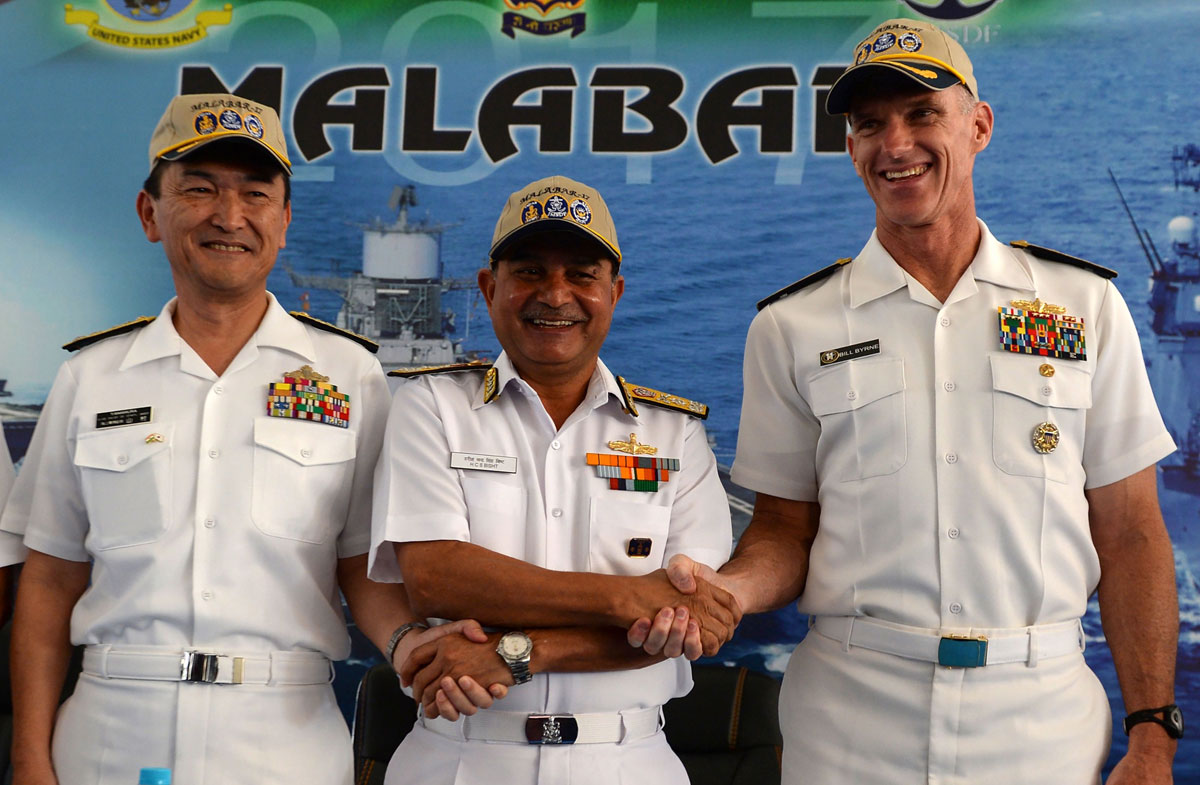India, U.S., Japan Naval Forces Engage in Malabar War Games
Japanese Rear Admiral Hiroshi Yamamura (l), U.S. Rear Admiral William Byrne (r) and H.C.S. Bisht, Vice Admiral of the Indian Navy, pose for photographers during the inauguration of joint naval exercises with the United States, Japan and India in Chennai, July 10. India began holding naval exercises with the United States and Japan off its south coast on July 10, seeking to forge closer military ties to counter growing Chinese influence in the region. (Arun Sankar/AFP/Getty Images)
The Navies of India, USA and Japan recently concluded the 21st edition of the annual Malabar exercise in the Bay of Bengal, the biggest so far. The thrust of war games at sea this year was on aircraft carrier operations, air defense, anti-submarine warfare (ASW), surface warfare, visit board search and seizure (VBSS), search and rescue, joint maneuvers and tactical procedures. The drills involved USS Nimitz, the world’s largest aircraft carrier, India’s lone carrier Vikramaditya and Japan’s biggest warship, Izumo, writes Siddharth Srivastava.
“Malabar 2017 is the latest in a continuing series of exercises that has grown in scope and complexity over the years to address the variety of shared threats to maritime security in the Indo-Asia Pacific,” the U.S. Pacific command said. The stated primary aim of the Malabar exercise is to increase interoperability amongst the three navies of India, US and Japan.
China Factor
The annual event, however, has for long been seen as a synchronized attempt by the three nations to contain the rising influence of China in the territorial waters of the Asia Pacific region, including South China Sea and the narrow but strategically significant shipping lane Malacca Strait, that connects East Asia to the Indian Ocean. New Delhi made it a point to delink the naval war games from the ongoing standoff with China at Doklam in Sikkim.
“The joint naval exercise is not connected to the border stand-off between Indian and Chinese forces. The Malabar exercise process starts a year in advance,” Indian Navy’s vice admiral H.C.S. Bisht told reporters. However, such diplomatic sophistry is never taken at face value by nations that do not trust each other. “While India has been careful to play down any maritime coalition with USA, the Malabar exercise cannot be seen in strictly military terms. There are subtle and not so subtle strategic games at play as well,” said Ashok Bhatnagar, a former director at India’s ministry of defense.
India, for instance, has been particularly concerned about China’s growing engagement with Pakistan. This is even as America has been looking to isolate and corner Islamabad over state support to terror networks.
Pakistan has recently been engulfed in another existential crisis with Prime Minister Nawaz Sharif being forced to resign following an adverse judicial verdict. This is going to result in a period of policy paralysis that will delay development projects. The constant tussle for supremacy in Pakistan between the Army, political leadership and the judiciary has taken a big toll.
Periodically, the underlying power struggle surfaces in the form of ugly and unwarranted ousters of democratically elected governments, unfounded allegations of corruption and military coups. Beijing sees an opportunity in making strategic inroads into the vulnerable polity of Pakistan even as U.S. withdraws, which India is unhappy about. China’s involvement in Pakistan includes the massive $55 billion China-Pakistan Economic Corridor (CPEC), a network of roads, rail links and power plants connecting western Xinjiang province to Pakistan’s southern ports of Gwadar and Karachi.

U.S. Eyes India Defense Mart
However, there is more than just the China angle that was at work during the Malabar exercises. The scale and intensity of the war games that were launched in the early 90s, have gathered momentum over the last decade.
This is the period that India has been pursuing a massive multi-billion-dollar import-driven defense modernization effort, with U.S. armaments playing an important part. Between 2012 and 2016, India was the world’s biggest defense importer followed by Saudi Arabia, UAE, China and Algeria, as per a report by Stockholm International Peace Research. India’s armed forces have, meanwhile, projected a need of $400 billion over the next five-years up to 2022 to meet upgradation and fleet augmentation needs that range from warships, submarines, fighter jets, drones, transport planes and helicopters.
No doubt, the Malabar exercises are a big opportunity for America to directly demonstrate their immense Naval capabilities to India. “The competition for contracts is fierce with Russian, Israeli, European and U.S. defense majors seeking to sell their state-of-the-art products. The hands-on experience of American armaments by the Indian Navy in the course of the Malabar engagements can only be a positive for their industry,” said Bhatnagar.
Recently, defense minister Arun Jaitley underlined India’s military aspirations. “Though all aspects of power constitute a super power, military power is a key to a nation’s rise to great or Super Power status,” he said.
Growing Indo-U.S. defense ties are naturally being noticed. In a July editorial, the state-owned China Daily underlined the same. “The 10-day Malabar naval exercises have begun and the U.S. approved a $365 million sale of military transport aircraft to India and a $2 billion deal for surveillance drones is in the works; it is China that should feel security concerns, given importance of Indian Ocean for its trade and oil imports,” the editorial said.


